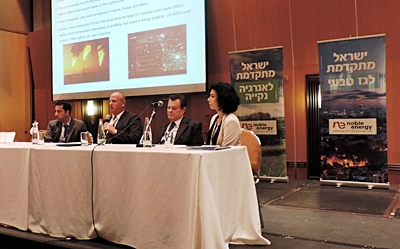EMGC ’14: Gas executives outline priorities to succeed on gas transportation fuels
3/12/2014 12:00:00 AM
 By ADRIENNE BLUME
By ADRIENNE BLUMEManaging Editor
TEL AVIV, Israel -- The second expert panel on Day 2 of Gulf Publishing Company's Eastern Mediterranean Gas Conference 2014 (EMGC 2014) was moderated by energy innovation and business development expert Dr. Lea Carmel Gordon, and focused on future applications for natural gas, including transportation fuels.
Panelists included Dr. Gordon; Eli Barnea, CEO of Sigma Epsilon; Gil Dankar, chairman of Dor Chemicals Ltd.; and Dan Gaziv, board member of Primus Green Energy (panelists from right to left in photo).
Electricity alternatives for Israel. Panelist Mr. Dankar spoke about the traditional sources of energy used in Israeli power generation, noting, "We need a cheaper product and a cleaner product ... There is a whole range of viable alternatives, so why don't we use them?"
Mr. Dankar expects methanol, compressed natural gas (CNG), electric vehicles and biofuels to continue to penetrate Israel's transportation fuel mix, with methanol and CNG leading the way. By 2030, nearly 50% of the traditional fuels used in Israeli transport will be replaced with alternative fuels, he said.
Mr. Dankar noted that, although methanol has met with some resistance in the EU as an alternative fuel option, Israeli test results of over 750,000 kilometers have shown no significant differences between 15% methanol (M15) gasoline and regular 85-octane gasoline. Slight improvements in emissions were also observed with the use of M15.
Flexible-fuel vehicles (FFVs), on the other hand, can accommodate up to 85% methanol and give significant emissions reductions. An experiment is set to commence in the near future with a Chevrolet FFV to study the differences between the use of high-methanol-content fuel and regular gasoline.
LNG vs. CNG for transport. Next, Dr. Barnea discussed options for producing natural gas-based fuels, including LNG, CNG, methanol, gas-to-liquids (GTL) and dimethyl ether (DME). Chemically transformed fuels, such as methanol, GTL and DME are more expensive than physically transformed fuels, such as LNG and CNG.
However, chemically transformed fuels are logistically superior to physically transformed fuels in that they are either liquids at ambient temperatures, or they require only moderate compression (i.e., DME). Also, chemically transformed fuels require lesser or no modifications to motor vehicles to ensure compatibility.
Dr. Barnea next compared CNG to LNG. While CNG is less expensive to produce, the distribution and storage of this fuel is more expensive than for LNG. CNG is also heavier and takes up more volume than does LNG. A major downside for LNG, by contrast, is that odorizing agents cannot be added; therefore, methane detectors must be installed.
Dr. Barnea concluded that the optimal niche for LNG transportation fuel is heavy-duty trucks, such as those used in the US. The US is a good benchmark for the Israeli market, he said, since both countries are developed economies that enjoy relatively low natural gas prices. By 2020, Dr. Barnea expects 2,000 ships to be moving LNG throughout the world as the LNG market—and the LNG transportation fuel niche market, in particular—continues to grow.
The panelist also warned that work to establish LNG facilities in Haifa and Ashdod, Israel must begin immediately, as ships visiting these harbors will no longer accept heavy fuel oil in the near future. If Israel does not take initiative now to build LNG infrastructure, Dr. Barnea said, "Israel will not have an LNG industry by 2020."
To promote market penetration of natural gas-based transportation fuels, fueling station networks, custom-made vehicles, and gas-based fuels must be simultaneously available. Government incentives, regulations and tax advantages will be required; otherwise, the market will develop too slowly and result in initial overcapacity, Dr. Barnea said.
Syngas-to-fuel on a small scale. The panel's final speaker, Mr. Gaziv from Primus Green Energy, spoke about the company's STG+ syngas-to-gasoline technology, which does not require gas infrastructure modifications or vehicle tailoring to accommodate Primus' GTL fuel. The STG+ technology is a five-step process that encompasses methanol synthesis, DME synthesis, gasoline synthesis, gasoline treatment and water separation.
Primus technology, which is presently in the demonstration stage and will enter commercial operation in 2016, is ideal for processing small, stranded reserves of US natural gas that are usually flared. The company is also looking to export modular units to Nigeria, Russia and other countries.






Comments